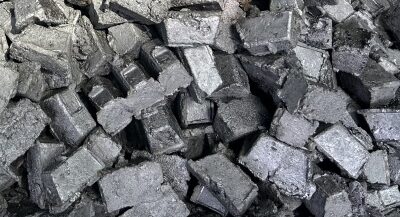
What is electrode paste?
The self-baking electrode paste is mainly made of electrically burnt anthracite, graphite powder, petroleum coke and leach. The electrode paste product is prepared by batching, kneading and molding, and the electrode paste is loaded into the electrode cylinder which has been installed on the ore thermal furnace. In the production process of the ore thermal furnace, the electrode is coked by the Joule heat generated when the current passes through the furnace and the conduction heat and radiation heat in the furnace. The self-baking electrode can be used continuously, and it can be lengthened and sintered while being used. The process of making the self-baking electrode is relatively simple, the production cycle is short, but its requirements for raw materials and ingredients formula and technical index control are very high, and the self-baking electrode can be 2000mm in diameter according to the electrode barrel, which is greatly increased Wide arc band, stable arc line, ensure hot melt efficiency, expand the volume of molten pool, increase product output, as an important raw material for self-baking electrode paste has been widely used in the production and use of various mineral thermal electric furnaces such as calcium carbide, ferroalloy, yellow phosphorus.
Self-baking electrode paste is also known as Soderbergh electrode, its development history can be traced back to 1909, when the Norwegian engineer Soderbergh did such an experiment, the unroasted carbon material in the electric furnace, the use of the input current joule heat and the electric furnace surface radiation heat to bake, the results successfully obtained self-baking electrode.
The self-baking electrode paste is composed of an electrode tube and its inner electrode paste. The electrode tube is made of steel plate rolled and welded, and there are fins and iron bars, which play the role of transferring current and increasing the strength of the electrode. The vertical rib of the electrode tube and the opening of the cross section solve the problem of separating the electrode paste from the electrode sheet, so that the electrode tube and the electrode paste are more firmly combined and easy to conduct the current. The electrode tube is installed in the electrode holder and extends to the reaction zone in the furnace through the electrode clamping device. The electrodes are constantly consumed while working in the furnace, so the electrodes are constantly lowered, the electrode paste is filled, and new electrode tubes are welded.
The electrode paste is loaded into the electrode cylinder, and the electrode cylinder moves downward at the same time, and is constantly consumed and constantly supplemented. In this process, the electrode paste has to undergo three phase changes, namely, a solid state, a liquid state and a solid state. At room temperature (25℃), the electrode paste is solid, when the temperature rises from 25℃ to 120~250℃, the electrode paste melts into a thin paste, while the resistance increases, and the temperature rises to 300~750℃. The volatile matter in the electrode paste evaporates and gradually becomes viscous, becomes a scorched substance, and the resistance gradually becomes smaller. When the temperature reaches 800~900℃, the electrode paste is basically burned into an electrode. In this transformation process, the electrode paste is roasted into an electrode, and its strength is gradually increased, while the resistivity is gradually reduced to below 100·m.
After high temperature roasting above 1000℃, the electrode paste is completely carbonized into a carbon electrode, which plays a role in conducting electricity and transforming energy in the smelting pool of the mineral thermal furnace, because the electrode cylinder is welded under the condition of no power failure, the electrode paste is also added under the condition of no power failure, and the electrode is constantly consumed The paste is continuously roasted to form an electrode, so it is called a continuous automatic roasting electrode, referred to as a self-baking electrode. The self-baking electrode is widely used in calcium carbide furnace and ferroalloy furnace. The diameter of this electrode can be increased to 2m, which creates favorable conditions for the application of ore-heating furnace with large load capacity.
